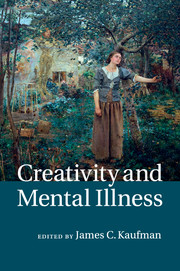Book contents
- Frontmatter
- Dedication
- Contents
- List of figures
- List of tables
- List of contributors
- Preface
- Acknowledgments
- Part I Creativity and mental illness: the state of the field
- 1 A socio-historical overview of the creativity–pathology connection: from antiquity to contemporary times1
- 2 The mad (creative) genius: what do we know after a century of historiometric research?
- 3 Reviewing recent empirical findings on creativity and mental illness
- 4 Building connections on sand: the cautionary chapter
- Part II Cognitive and neuroscientific perspectives on creativity and mental illness
- Part III Creativity and the spectrum of mental illness
- Part IV Creativity and mental illness: possible commonalities
- Part V Creativity and mental health
- Part VI Creativity and mental illness: what now?
- Index
- References
1 - A socio-historical overview of the creativity–pathology connection: from antiquity to contemporary times1
from Part I - Creativity and mental illness: the state of the field
Published online by Cambridge University Press: 05 August 2014
- Frontmatter
- Dedication
- Contents
- List of figures
- List of tables
- List of contributors
- Preface
- Acknowledgments
- Part I Creativity and mental illness: the state of the field
- 1 A socio-historical overview of the creativity–pathology connection: from antiquity to contemporary times1
- 2 The mad (creative) genius: what do we know after a century of historiometric research?
- 3 Reviewing recent empirical findings on creativity and mental illness
- 4 Building connections on sand: the cautionary chapter
- Part II Cognitive and neuroscientific perspectives on creativity and mental illness
- Part III Creativity and the spectrum of mental illness
- Part IV Creativity and mental illness: possible commonalities
- Part V Creativity and mental health
- Part VI Creativity and mental illness: what now?
- Index
- References
Summary
Writing around the turn of the middle of the twentieth century, the renowned literary critic Lionel Trilling (1945/1950, pp. 160–161) published an essay, “Art and neurosis,” in which he sought to expose as an insidious “myth” what he called “one of the characteristic notions of our culture,” the idea of an intimate connection between artistic creation and mental illness. However, like two noteworthy earlier critiques, Charles Lamb’s (1826) The sanity of true genius and George Bernard Shaw’s (1895/1909) The sanity of art, Trilling’s essay remains little more than a footnote in the rapidly expanding literature on the topic of creativity and psychopathology. Indeed, the belief in a close connection between genius or, more generally, creativity and illness has sprung ever deeper roots in the cultural fabric of Western society, a development that received new impetus from the weight of support from both clinical and non-clinical studies published over the course of the past three decades. Before then, few of the studies expounding a pathology position were focused on clinical diagnosis. Most of them, based primarily on biographical and anecdotal accounts of those viewed as geniuses, produced highly conjectural findings. However, starting in the 1980s, one witnesses the continuing use of historical sources regarding the eminent, in addition to clinical studies in the form of psychiatric and psychometric approaches. These clinical studies involved comparisons of living creative with living non-creative individuals. Notwithstanding dissenting views, the combined force of the most recent studies has led to something resembling a consensus, one that views the link between creativity and illness as a genuine, pervasive, and timeless phenomenon with decided biological roots that most often takes the form of manic-depressive illness or related types of mood disorders.
- Type
- Chapter
- Information
- Creativity and Mental Illness , pp. 3 - 24Publisher: Cambridge University PressPrint publication year: 2014
References
- 13
- Cited by



